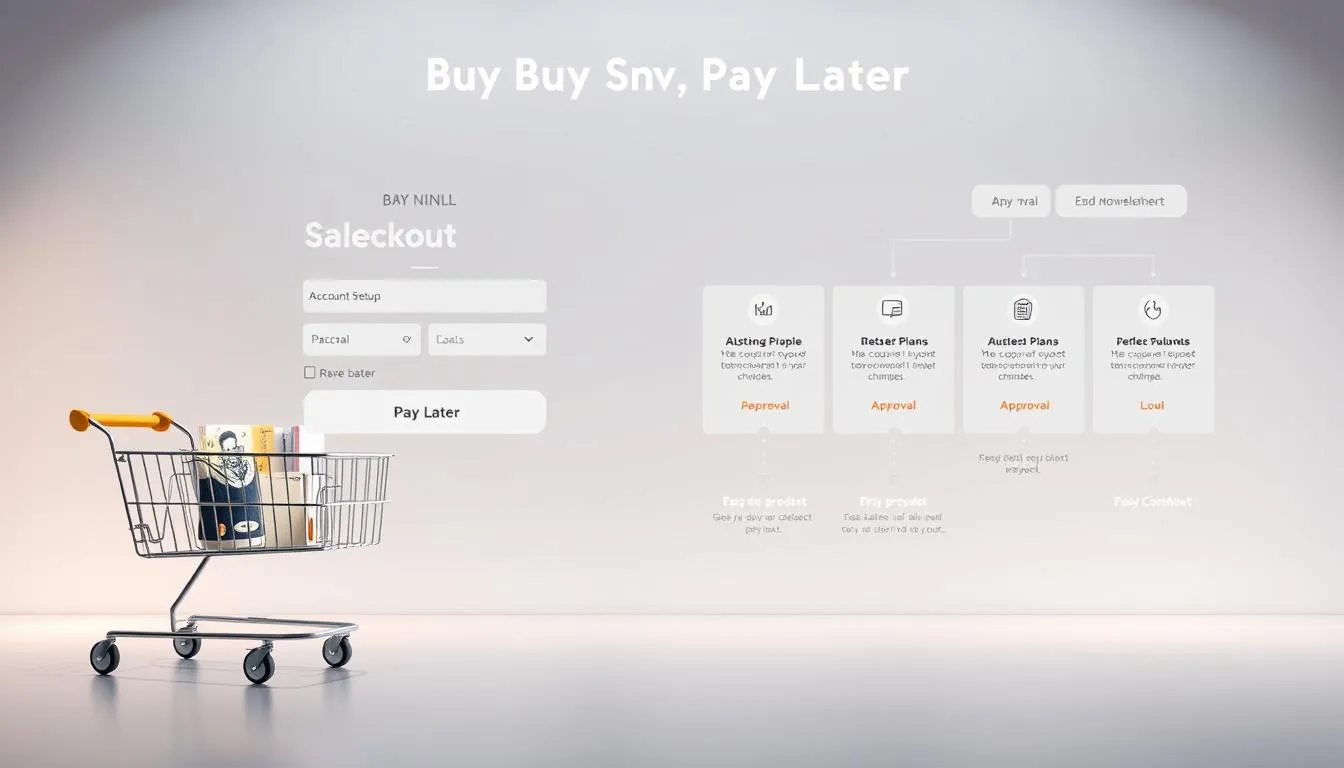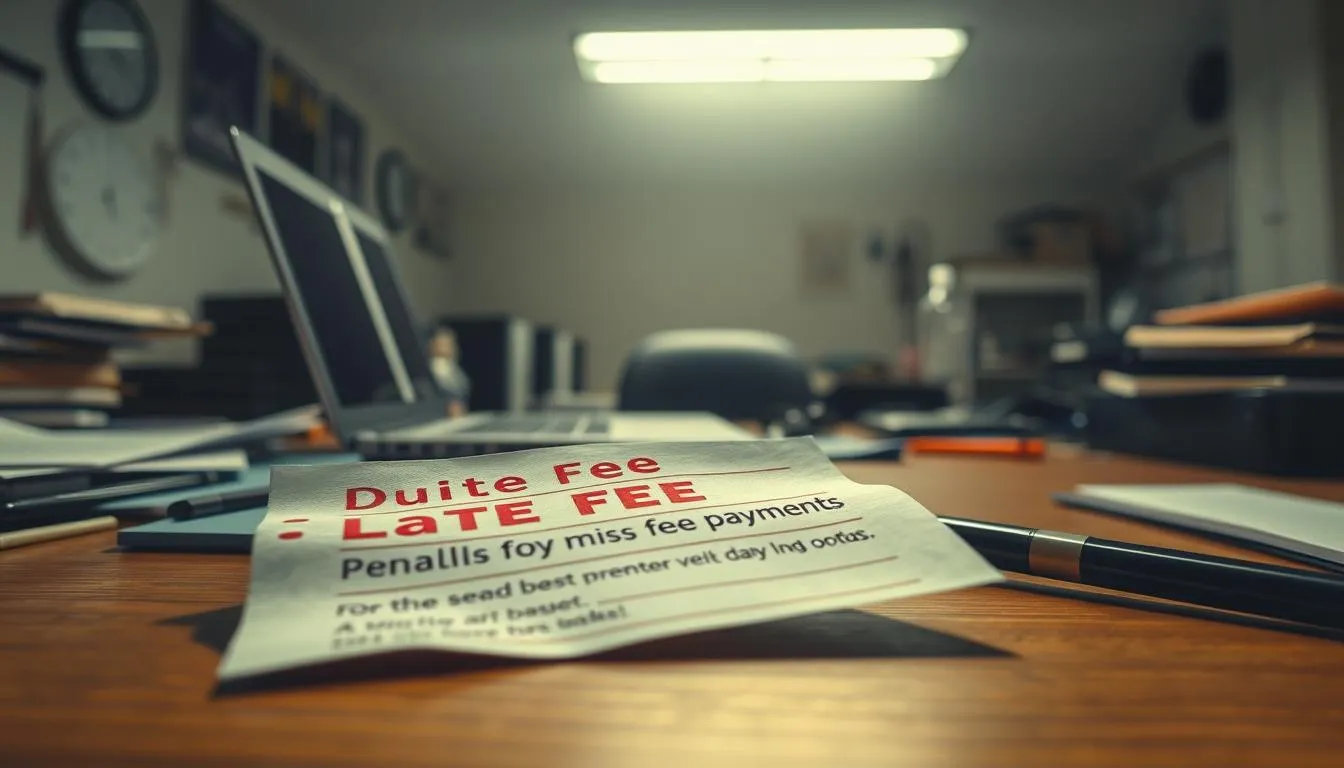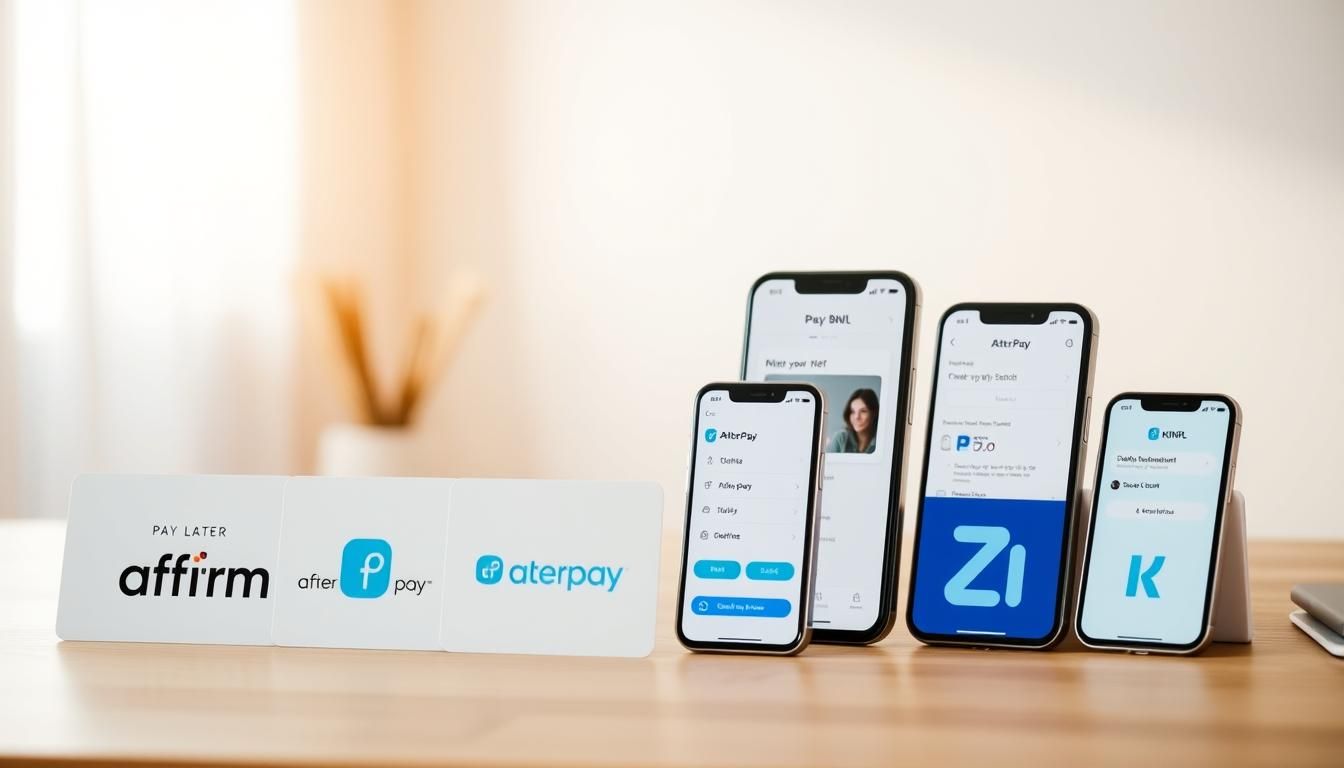Surprising fact: consumer use of buy-now-pay-later surged from about $2 billion in 2019 to $24.2 billion in 2021, and U.S. purchases were estimated near $46 billion in 2024.
This short guide helps everyday shoppers compare easy pay later options without jargon. We explain how the app-driven service works, how it compares to traditional credit, and why you now see payment buttons at many checkouts.
Expect plain-English insights on approval differences, short repayment terms, costs, and customer service so you can pick a plan that fits your budget. We’ll also look at consumer financial protection and what regulators are watching as the market grows.
For a deeper look at how these services work in commerce and merchant benefits, see a practical explainer at Shopify’s buy-now-pay-later guide.
Key Takeaways
- Buy-now-pay-later is a fast-growing payment service that splits purchases into installments.
- It differs from credit cards in checks, term length, and potential costs.
- Compare total costs, schedules, and customer support before choosing a plan.
- Regulators are watching debt buildup and data practices, so know your protections.
- Use it for short-term needs and track repayments to avoid credit harm.
What Is BNPL? A Friendly Beginner’s Guide to “Buy Now, Pay Later”
Buy-now-pay-later is a short-term way to pay later by breaking a purchase into predictable, equal payments at checkout. A typical plan lets you pay an initial amount up front, then split the rest into installments — often four payments spread over weeks.
How it differs from credit and loans: Unlike a credit card or a bank loan, this alternative uses a quick, often soft credit check and gives near-instant approval at the point of sale. It favors rigid schedules over revolving balances.
- Simple schedules: “Pay in 4” examples usually require one down payment, then three equal payments every two weeks.
- Merchant payment: A bnpl service pays the seller up front, which is why retailers promote these options.
- Eligibility: Basic personal details and a soft check determine approval and spending limits.
Remember: short plans can be interest-free if you pay on time, but longer-term loans may carry interest. Consumers should read terms and treat pay-later options like any other form of credit to avoid fees or score impacts.
How BNPL Works at Checkout
At checkout, a quick approval can turn a cart into a paid order in seconds. You pick a pay later option, the provider runs a soft credit check, and an instant decision appears that is tied to the size of your purchase.

If approved, the financier pays the merchant right away. Then you repay the lender in scheduled installments—common plans split the balance into four payments over six weeks. Some longer plans add interest for bigger buys.
Autopay is common and draws funds from a linked debit or credit account on due dates. This convenience helps avoid missed payments but can reduce flexibility when cash is tight.
- Who gets paid: merchants receive funds immediately; bnpl lenders collect your scheduled payments.
- Timing and fees: terms, grace periods, and merchant fees (often 2%–8%) vary by provider.
- Data and choices: providers compete on speed, approval rates, app design, and data practices—so read terms before you confirm.
Benefits and Drawbacks: The Essentials for New Users
Short-term installment options can simplify budgeting for one-time purchases without adding a new card.
Pros: A clear pay later schedule often breaks a cost into predictable pieces. That makes tracking easier and can be interest-free if you pay on time. Many services approve a high share of applicants—some providers were near 78% approval—so consumers without strong credit can still access a plan.
Cons: The main risks are stacking too many small buys and juggling multiple due dates. The more schedules you carry, the more you will likely miss payment dates. U.S. defaults on these short plans ran low (about 2% in 2019–2022), lower than credit card defaults, but autopay requirements can trigger overdrafts or reduce flexibility when funds are tight.
Practical tips:
- Start small and track every schedule in one app or calendar.
- Align due dates with paychecks to avoid overdraft fees.
- Compare total cost and protection policies—refunds and returns may differ from a card.
| Feature | Benefit | Consumer Risk |
|---|---|---|
| Short-term plan | Predictable payments, often interest-free | Can add monthly obligations if mismanaged |
| High approval | Access without a card, faster checkout | May encourage extra spending |
| Autopay | Reduces missed payments | May cause overdrafts if balance is low |
Costs, Interest, Late Fees, and What Happens If You Miss a Payment
Not all pay-later offers are equal — some carry interest or hidden charges. Many short-term plans are interest-free if you meet the schedule. Longer plans can act like small loans and charge annual rates that climb as high as about 30%.

Interest-free vs. interest-bearing options
Know the math: an interest-free installment plan keeps cost low when paid on time. If a plan mentions APR or longer terms, treat it like a loan and compare total cost before you buy.
Late fees, collections, and junk-fee concerns
Missed payments often trigger late fees and returned-payment charges. Regulators have flagged repeated penalties as “junk fees” when several charges stack on one slip-up.
Persistent delinquency can move an account to collections and harm your credit score.
Manage multiple purchases and avoid overdrafts
- Tip: align due dates with paydays and keep a small buffer in your account.
- Tip: track all installment plans in one place and review dispute and hardship policies before you buy.
- Tip: enable alerts so you are less likely to miss payment and incur extra fees.
BNPL and Your Credit: Reporting, Scores, and What Lenders See
How your short-term installment plans show up on a credit report matters more than you might think. Many providers do not report on-time payments to bureaus, so routine, timely repayments often won’t boost your score.
Why many short plans don’t build credit — and how missed payments can hurt
On-time behavior is helpful but only if it’s shared. Most short, pay-in-4 products are invisible to credit bureaus. That means paying on time may not raise your credit history.
However, missed payments can be reported or sent to collections. A late mark can lower your consumer credit and remain on file for years.
Evolving reporting: FICO, bureaus, and provider data-sharing
Reporting rules are changing. Affirm shares some consumer data with Experian and TransUnion. Klarna reports longer-term loans in the U.S., but not most short plans.
FICO has explored adding installment activity to scores, while some providers warn legacy models could misread short-term behavior.
| What appears on file | Typical effect | What to do |
|---|---|---|
| On-time short installment | Often no score benefit | Track payments; don’t rely on score gains |
| Late payment or collection | Can lower score and harm applications | Contact lender, dispute errors, check reports |
| Long-term loan reported | Builds history if positive | Use like a credit card for long-term strategy |
Practical tip: treat these plans as real credit. Budget for each due date, check your credit reports regularly, and review your providers’ reporting policies. Policies evolve, so revisit them to see if positive behavior starts to count toward financial protection and better access from lenders and credit card issuers.
Consumer Protections and Dispute Resolution
When a purchase goes wrong, the pathway to resolution can differ a lot from using a credit card.
Know where you stand before you buy: consumer protection rules vary by product and provider. Read the provider’s policy so you know if refunds, paused payments, or chargebacks apply.

How protections differ from credit cards
Credit cards typically offer stronger chargeback rights. Many providers do not mirror those rights, so you may have fewer automatic options if a merchant won’t resolve a problem.
Returns, chargebacks, and resolving merchant disputes
Start with the retailer. Most refunds must be processed by the seller first, and payments may continue until the refund posts.
Some lenders offer internal dispute resolution. Timelines and rules vary, so save receipts, emails, and tracking numbers to speed any claim.
Protection Bureau insights and complaint options
The Consumer Financial Protection Bureau has flagged gaps in disclosure and protections, and it has asked major firms to share business practices. The CFPB coordinates with other regulators on oversight.
If you can’t get a fair outcome: file a consumer financial protection complaint online or call (855) 411-CFPB (2372).
- Practical steps: document the issue, contact the merchant, then escalate to the provider with records.
- Check whether payments pause during disputes and how refunds affect your payment schedule.
- Read protection pages and rules before you confirm a purchase so you know the available resolution path.
| Issue | Typical process | What to document |
|---|---|---|
| Late or missing item | Contact merchant → provider if unresolved | Order number, tracking, messages |
| Faulty product | Return policy → refund posts to lender | Photos, receipts, return confirmation |
| Unpaid dispute | File complaint with protection bureau | All correspondence, payment history |
Tip: rules differ by plan type and provider. Align expectations with the protections offered so you can reach a fair resolution if things go wrong.
Who Uses BNPL in the United States Today
Usage of short-term installment apps cuts across income groups, from cash-strapped households to high earners juggling family bills.
New York Federal Reserve data shows heavier repeat use among financially fragile households: nearly 60% of that group used these plans five or more times in the past year. That data highlights why budgeting matters for repeat users.
Age and gender trends show younger consumers — Gen Z and younger Millennials — are overrepresented compared with traditional credit holders. Early growth leaned on women, but recent surveys find men slightly more likely to have used these services.
Adoption spans many credit levels. Some high-income borrowers and parents with young children are also among those most likely miss payment. In short, it’s not only lower-income shoppers who face risk.
- Why it grows: quick approvals, simple schedules, and smooth app experiences.
- What to do: track multiple loans and line up due dates with paychecks to avoid overlap.
Key Markets and Use Cases: From Groceries to Travel
Consumers now split a wide range of purchases into installments, from weekly groceries to festival tickets. This shift creates two clear use cases in the U.S. market.
Food and grocery: Grocery purchases made up about 40% of global online pay later value in 2024. A 2025 LendingTree survey found nearly a quarter of U.S. users used pay later for groceries, up from 14% a year earlier. Retailers and delivery apps like Klarna with DoorDash set limits (for example, sub-$35) to keep small buys manageable.
Travel and experiences: Travel shows a different pattern. Young adults increasingly use pay later for flights, festival tickets, and trips. Afterpay and others reported surges in ticket purchases, and one 2025 report found almost 60% of Coachella attendees used pay later to finance tickets.
Practical note: The Federal Reserve finds many financed purchases sit under $250, but mid-range loans exist for travel. Treat each purchase like real credit: check total cost, compare fees, and track payments so many small baskets don’t become a large balance.
“Use pay later options for convenience, but review terms so you know the full cost.”
For regulatory research and pilot findings, see this pilot study on pay later services.
BNPL for Online Shopping: Choosing the Right Plan
Choosing the right pay later option starts with a clear look at total cost, not just the per-payment amount.
Compare terms: installments, interest, fees, and total cost
Check the schedule first. Note how many installments you’ll make and when each payment posts to your account. Look for any interest on longer plans and a clear listing of late fees.
Read the disclosure to calculate the full cost over time. A small per-payment number can hide interest or service charges that raise the purchase price.
Evaluating lenders: reputation, protections, dispute resolution
Pick a bnpl service or lender with clear statements, easy alerts, and fast support. Scan reviews for how refunds and disputes are handled.
- Verify dispute resolution steps and how refunds pause payments.
- Choose services that post clear receipts and send reminders before due dates.
- When possible, match short pay later products to small carts; use longer plans only when the cost and protections make sense.
| What to compare | Why it matters | Quick check |
|---|---|---|
| Installments & timing | Affects cash flow | Align due dates with paychecks |
| Interest & fees | Drives total cost | Compute APR if shown |
| Dispute process | Protects you on returns | Read refund policy |
The Merchant and Lender Side: Fees, Data, and Market Dynamics
Merchants and lenders balance higher processing costs against clearer sales lifts when deciding which payment options to add.
Processing fees for these plans commonly run about 2%–8%, higher than many credit cards and typical interchange (roughly 1.3%–3.5%). No-surcharge clauses in contracts often stop merchants from adding a visible fee at checkout, so retailers must absorb costs or steer shoppers toward cheaper options subtly.
Why merchants accept higher fees
Retailers tolerate bigger charges because alternative pay options lift conversion, grow average order size, and attract new customers.
That conversion boost can offset upfront costs, but sellers should weigh refunds, chargebacks, and added support work when calculating ROI.
Data, apps, and revenue pressure
bnpl lenders invest in slick apps that can become closed-loop shopping ecosystems. Purchase histories and other data power targeted offers and cross-promotion.
That use of data raises privacy and marketing concerns, and lenders are hunting new revenue as competition squeezes margins.
Practical note: compare total ROI—not just the per-transaction fee—against conversion gains, operational load, and evolving market rules as big tech and payment networks re-shape product design.
Regulation and Oversight in the U.S. Market
Regulators have begun closely tracking new installment services as they reshape short-term borrowing.
CFPB priorities and actions
The Consumer Financial Protection Bureau has issued information requests to Affirm, Afterpay, Klarna, PayPal, and Zip.
The protection bureau wants details on accumulating debt, regulatory arbitrage, and data practices that could affect consumers.
That scrutiny aims to spot risks like overlapping plans, surprise late fees, and uneven dispute rights versus credit cards.
Federal Reserve insights and coordination
The Federal Reserve and regional banks report rapid growth after the pandemic, with many purchases under $250.
Those patterns raise concerns about household budgets and the need for clearer financial protection.
- Findings from the protection bureau can shape future disclosures and reporting rules.
- Regulators are coordinating with the Federal Reserve System and international partners to monitor outcomes.
- Better protections and consistent reporting could boost transparency and reduce consumer confusion.
“Oversight seeks to keep innovation moving while reducing risks and protecting consumers.”
Conclusion
Make a final habit of confirming total cost, account link, and refund rules before you finish checkout. ,
Recap: short-term pay later plans can spread a purchase over time, but they are still credit. Read terms, note schedules, and add reminders so every payment posts on time.
Compare bnpl products and lenders for fees, dispute paths, and support. Remember that some bnpl loans won’t boost consumer credit when paid on time, yet missed payments can still harm your score.
Financial protection efforts and the protection bureau are watching data and reporting practices. Revisit provider policies often so changes in reporting do not surprise you.
Quick checklist: confirm total paid, verify protections, know due dates, and keep your budget front and center. Used wisely, a bnpl service can be a practical tool for online shopping without derailing your finances.
FAQ
What does “buy now, pay later” mean and how is it different from a credit card?
Buy now, pay later is a short-term payment plan that splits a purchase into installments at checkout. Unlike most credit cards and traditional loans, many plans offer interest-free periods and quick, point-of-sale approval. Cards usually give a revolving line of credit with interest on carried balances, while installment plans set a fixed schedule and may have fewer ongoing fees.
How does approval work at checkout and will a credit check affect my score?
Most providers run a soft credit check or use alternative underwriting, which doesn’t affect your credit score. Some longer or larger plans may trigger a hard inquiry. Approval is usually instant, showing available plans and repayment schedules before you confirm the purchase.
Who gets paid when I use a pay-later service at a store or online?
The merchant typically receives payment upfront from the lender or service provider. You then repay the lender according to the installment schedule. That separation lets merchants get sales revenue immediately while the lender assumes the payment risk.
Can I set up autopay or link a card or bank account to avoid missed payments?
Yes. Most services let you link a debit/credit card or bank account and enable autopay. Autopay reduces the chance of missed payments but you should monitor balances and grace periods to avoid overdrafts or declined transactions.
What are the main benefits of using a pay-later plan for online shopping?
Benefits include easier budgeting through fixed installments, access to purchases without a credit card, and often interest-free terms for short periods. It can be useful for spreading cost on planned buys without paying credit card interest if you pay on time.
What are the risks and drawbacks I should watch for?
Risks include missing payments, which can trigger late fees, collections, and damage to relationships with lenders. Using multiple plans can create overlapping schedules and higher total debt. Also, easy checkout can encourage overspending.
Do buy-now-pay-later plans charge interest or only late fees?
It varies. Many short-term installment plans advertise interest-free options, but longer-term or promotional plans may charge interest. Late fees, returned-payment fees, and collection costs can apply if you miss payments, so read the terms before you commit.
Will using pay-later services build my credit score?
Often it won’t. Many lenders don’t report on-time payments to major credit bureaus, so regular use may not boost your score. However, missed payments can be reported and harm your credit. Some providers now report both positive and negative activity — check each lender’s reporting policy.
How do returns and disputes work compared with credit card chargebacks?
Returns usually follow the merchant’s policy, but you still must inform your lender. Credit cards offer robust chargeback protections; some pay-later services have weaker dispute paths. If a merchant won’t resolve a problem, escalate to the lender and consider filing a complaint with the Consumer Financial Protection Bureau.
What consumer protections should I expect and where can I complain?
Protections vary. Credit cards have strong federal protections under laws like the Truth in Lending Act. Pay-later services fall into evolving regulation; you can file complaints with the Consumer Financial Protection Bureau if you face unfair practices, unexpected fees, or data issues.
Who uses pay-later services most and which groups face higher risk of missed payments?
Use is common among younger shoppers, including Gen Z, and people without traditional credit access. Those with fragile finances or variable income face higher risk of missing payments, which can lead to fees, collection actions, and credit harm.
Are there common use cases where pay-later makes sense or doesn’t?
It can be sensible for planned purchases like small appliances, travel bookings, or higher-cost experiences when you need short-term flexibility and you can meet the payment schedule. It’s less wise for everyday impulse buys or when you lack a clear repayment source.
How should I compare plans and lenders before choosing one?
Compare total cost (fees and interest), payment schedule, late fee policies, credit reporting, dispute resolution, and provider reputation. Check merchant terms and whether the service harvests data or integrates with loyalty apps before deciding.
What fees do merchants and lenders face, and how does that affect prices?
Merchants pay fees to providers, often higher than card interchange, which can influence pricing or no-surcharge policies. Lenders may monetize data and drive repeat purchases through targeted offers, so consider privacy and marketing impacts alongside cost.
How are regulators responding to the growth of pay-later products in the U.S.?
Agencies like the Consumer Financial Protection Bureau and the Federal Reserve are monitoring market growth, data practices, and consumer harm. Expect evolving rules on disclosures, fee limits, and reporting requirements as regulators close gaps between these services and traditional credit oversight.
